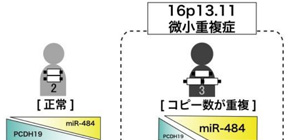
Elucidating the mechanism of pathogenesis by chromosome duplication for neurodevelopmental disorders
Shedding light on new treatments for neurodevelopmental disorders like attention deficit hyperactivity disorder
Abstract
The research group of Osaka University Graduate School of Medicine Department of Molecular Neuroscience professor YAMASHITA Toshihide and assistant professor FUJITANI Masashi (at the time of research; currently associate professor at Hyogo College of Medicine Department of Anatomy) was the first in the world to discover the neurodevelopmental disorder *1 -causing molecule micro RNA-484 (miR-484) produced by the microduplication of the 16p13.11 site of chromosome 16 *2 .
The duplication of the 16p13.11 site has been garnering attention as a cause for attention deficit hyperactivity disorder (ADHD) and intellectual disabilities, etc.; however, up to this point the mechanism of this cause has remained unclear. In this study, our research group revealed that the abnormal expression of miR-484, due to the duplication of 16p13.11, causes changes in the expression of the molecule involved in regulating development of the brain, protocadherin-19, and causes embryonic neurogenic abnormalities.
It is expected that the present research results will lead to the development of novel treatments for neurodevelopmental disorders.
Research Background and Contents
It is widely known that a slight duplication or deletion of chromosomes is the cause of various diseases. Among these, it has been known that duplication of the 16p13.11 site, a small part of chromosome 16, causes the development of neurodevelopmental disorders. Yet, the molecule causing this was not clear. In this research group, focusing on the eight regions within the duplication site based on patient information obtained from public databases, the expression and workings of these genes were revealed in a mouse brain. Further, using the BAC transgenic method, the human duplication site was built into the mouse genome. When observed, it was found that they exhibited neurogenic abnormalities and symptoms of neurodevelopmental disorders and it was possible to elucidate the pathogenesis of neurodevelopmental disorders through the duplication of specific chromosomal sites. Furthermore, functional analysis was conducted and, of the eight genes within the duplication site, it was ascertained that miR-484 was the gene responsible. miR-484 was being expressed when nerve cells in the cerebral cortex were formed, promoting the differentiation of neural stem cells into nerve cells. Accordingly, it was thought that, when miR-484 is overexpressed due to chromosome duplication, the balance of neural stem cell proliferation collapses and its differentiation facilitates. Eventually, pathology occurs (Figure 1). Additionally, the fact that miR-484 exhibits the function of suppressing the expression of pcdh19 was also revealed.
The impact of this research on society (study significance)
Through the revelation of the pathological mechanism of the microduplication of 16p13.11, it was possible to identify the molecules involved in neurodevelopmental disorder onset. In the future, the further elucidation of the molecular mechanisms of neurodevelopmental disorders and its development into novel therapies is expected.
Terminology
*1. Neurodevelopmental Disorders
A group of diseases that occur in the developmental stage. The behavioral abnormalities span a wide range, from the very limited, such as control of learning or executive function, to overall failure of social skills or intelligence. Autism spectrum disorder, attention deficit hyperactivity disorder (ADHD), intellectual disability, etc. are included. Though the cause of these disorders is generally considered to be brain abnormalities in different systems, the comorbidity of each is also common and the cause is unknown.
*2. 16p13.11 Microduplication
There are a variety of gene duplication syndromes, from the large duplication of the chromosome itself in Trisomy 21 (Down syndrome) etc., to microduplication, in which a number of copies of a small part of a chromosome (several megabase) are duplicated. Among these, patients that have duplication of a micro-region of approximately 1.5 megabase of the 16p13.11 region and exhibit symptoms are referred to as 16p13.11 microduplication syndrome. Up to this point, causes, candidate genes, etc. have been completely unknown. The duplication of the 16p13.11 region has been reported to be a risk for a variety of neurodevelopmental disorders.

Figure 1
When miR-484 is overexpressed due to chromosome duplication, the balance of neural stem cell proliferation collapses and its differentiation facilitates. Eventually, pathology occurs
To learn more about this research, please view the full research report entitled “ A chromosome 16p13.11 microduplication causes hyperactivity through dysregulation of miR-484/protocadherin-19 signaling ” at this page of the Molecular Psychiatry website.
Related link
